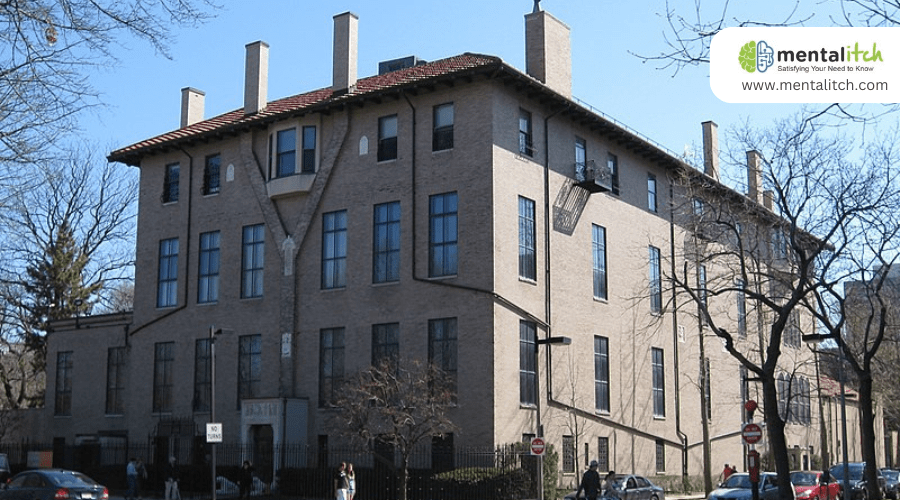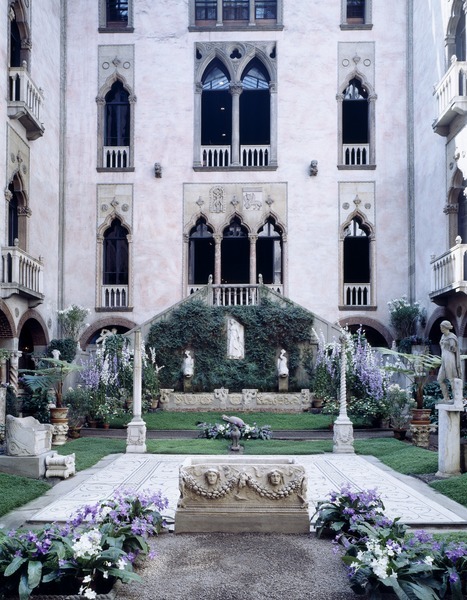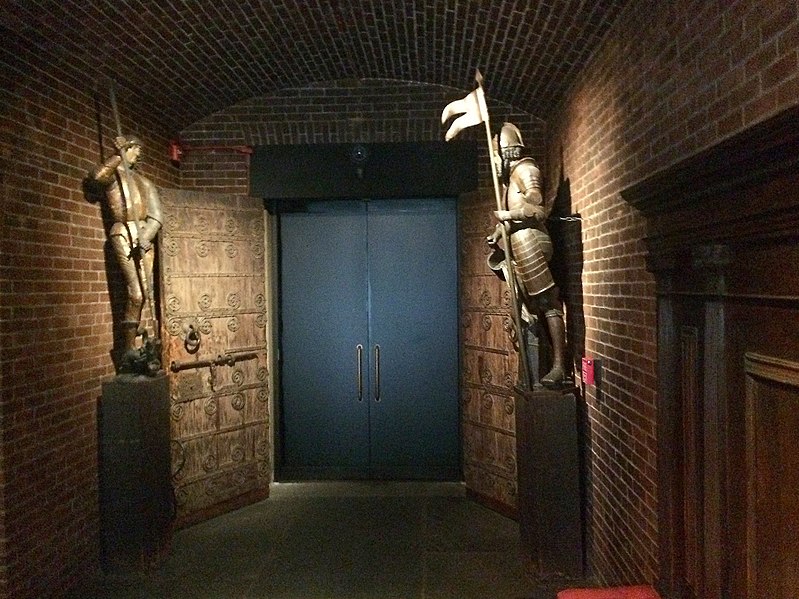In 1990, one of the most daring art heists in history took place at the Isabella Stewart Gardner Museum. Disguised as police officers, the thieves stole 13 priceless artworks, including masterpieces by Vermeer and Rembrandt, worth over $500 million. Despite extensive investigations, these treasures vanished without a trace, leaving experts baffled and the art world in shock.
About Isabella Gardner Museum
The Isabella Stewart Gardner Museum, located in Boston, Massachusetts, showcases a significant collection of European, Asian, and American art, including paintings, sculptures, tapestries, and decorative arts.
Isabella Stewart Gardner spent decades collecting art during her travels with her husband, John (“Jack”) Gardner. Their extensive collection, spanning over 2,500 objects from antiquity to the 1920s, features many works acquired by the renowned connoisseur Bernard Berenson, particularly from Italian and Dutch masters. Following her husband’s death in 1898, Gardner continued with plans to open a private museum to house their collection.
However, the famous museum suffered a major theft.
The Heist Overview
In 1990, thieves disguised as police officers executed a meticulously planned heist at the museum, stealing 13 pieces of art which includes masterpieces by Vermeer, Rembrandt, and Degas, making it one of the largest property crimes in history. The thieves spent 81 minutes inside the museum, bypassing its security and selecting specific pieces.
The impact on the Gardner Museum was profound. Losing such significant works not only diminished the collection but also sent repercussions through the art community. The museum has since offered a $10 million reward for information leading to the return of the stolen works, highlighting their irreplaceable value and the desperation to recover them.
Despite extensive investigations and numerous tips, the stolen art remains missing. The museum continues to appeal to the public for any information that could lead to the recovery of these treasures, hoping that one day the masterpieces will be returned to their rightful place, restoring the Gardner Museum’s collection to its former glory.
Thieves in Disguise
Disguised as police officers, the thieves tricked the museum’s security and pulled off the heist with great skill. They arrived at the Museum early on March 18, 1990. They pretended to be responding to a disturbance call.
Once inside, the thieves quickly overpowered the guards, handcuffing and blindfolding them. They then moved freely through the museum, choosing and stealing 13 priceless pieces of art.
The empty frames still hang in the museum, reminding everyone of the theft. Despite a multi-million dollar reward offered by the U.S. Attorney’s Office, the stolen art has not been found.
The Stolen Masterpieces
The stolen art pieces from the Isabella Stewart Gardner Museum heist on March 18, 1990, include the following 13 works:
- The Concert by Johannes Vermeer
- The Storm on the Sea of Galilee by Rembrandt van Rijn
- A Lady and Gentleman in Black by Rembrandt van Rijn
- Self-Portrait by Rembrandt van Rijn (a small etching)
- Landscape with an Obelisk by Govert Flinck (previously attributed to Rembrandt)
- Chez Tortoni by Édouard Manet
- La Sortie de Pesage by Edgar Degas
- Program for an Artistic Soirée by Edgar Degas
- Cortege aux Environs de Florence by Edgar Degas
- Three Mounted Jockeys by Edgar Degas
- Chinese Bronze Gu (a beaker or vessel)
- Napoleonic Finial (a finial in the shape of an eagle)
- An Ancient Chinese Ku (another type of vessel)
The Dutch Room
Motion detectors captured the thieves’ every move in the Dutch Room during the infamous heist. It indicated that the criminals spent a significant amount of time in the room carefully removing the artworks from their frames.
The heist targeted masterpieces that weren’t only valuable but also significant to art history. The loss of Vermeer’s ‘The Concert’ and Rembrandt’s ‘The Storm on the Sea of Galilee’ has left a void in the art world that remains unfilled.
The once a sanctuary of timeless art, now stands as a poignant reminder of what was lost during that fateful night.
Early Suspects
During the initial investigation, suspicion quickly fell on museum guard Rick Abath due to his peculiar behavior on the night of the heist. Abath’s actions raised eyebrows as he opened the museum door for the disguised thieves, seemingly without hesitation. Despite his questionable conduct, no concrete evidence linked him to the theft.
Another early suspect was Whitey Bulger, a notorious Boston mobster. Given his criminal influence in the region, authorities speculated his potential involvement. Similarly, Brian McDevitt, a former security guard, faced scrutiny, but like Abath, no hard evidence emerged. Various suspects, including Bobby Donati, William P. Youngworth, and George Reissfelder, were also investigated for ties to the heist.
| Suspect | Background |
| Rick Abath | Museum guard on duty |
| Whitey Bulger | Boston mobster |
| Brian McDevitt | Former security guard |
| Bobby Donati | Suspected mafia associate |
Even decades later, the U.S. Attorney’s office is still seeking viable leads.
Mafia Connections
Investigators turned their focus to the Boston Mafia, suspecting its pivotal role in orchestrating the heist. The FBI believed that the intricate planning and execution of the theft indicated the involvement of a well-organized criminal group. Various suspects, including Bobby Donati and George Reissfelder, had ties to the Boston Mafia, further supporting the theory of mafia connections.
The stolen artworks, including masterpieces by Vermeer, Rembrandt, and Degas, were thought to be used as collateral within criminal networks. The museum and the FBI have been offering a $10 million reward for information leading to the return of the stolen pieces. Anthony Amore, the museum’s Director of Security, has been vocal about ongoing efforts to recover the missing works.
Despite numerous leads, only a portion of the works has been traced back to potential mafia connections, and none have been recovered. The investigation remains active, with the hope that the substantial reward will eventually lead to the return of the stolen masterpieces.
The art community continues to hold out hope for the recovery of these invaluable missing works.
Investigation Efforts
The FBI’s investigation into the heist has utilized advanced techniques, such as DNA analysis and police sketches, to track down the elusive thieves. Initially, the focus was on the thieves’ movements, noting how they cleverly disguised themselves in police uniforms to gain entry. Despite these efforts, the identities of the culprits remain unknown.
To incentivize the recovery of the stolen art, the Museum is offering a substantial reward of $10 million for information leading to their safe return. This reward aims to encourage anyone with inside knowledge to come forward and assist in the restoration of the valuable pieces.
The FBI has analyzed numerous leads, including anonymous letters and tips, employing both traditional investigative methods and cutting-edge technology. As the search continues, the Museum and the FBI remain hopeful that new information will surface, aiding in the recovery of the stolen art and bringing those responsible to justice.
The Ongoing Mystery
Despite extensive investigative efforts, the Isabella Stewart Gardner Museum art heist remains an enduring enigma that has intrigued the public for over three decades. The Museum’s commitment to recovering the stolen works has never wavered.
Currently, besides the $10 million reward, an extra $100,000 is available for the return of the Napoleonic eagle finial.
Conclusion
As the quest for answers continues, perhaps the key to unlocking this mystery lies within the public’s vigilance. Imagine being the one to provide the crucial tip that finally brings these masterpieces back to their rightful home. The resolution of this enduring enigma could restore not only the lost art but also a significant part of cultural history, making the Isabella Stewart Gardner Museum whole once more.



